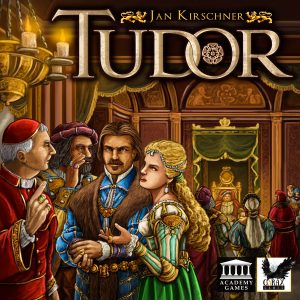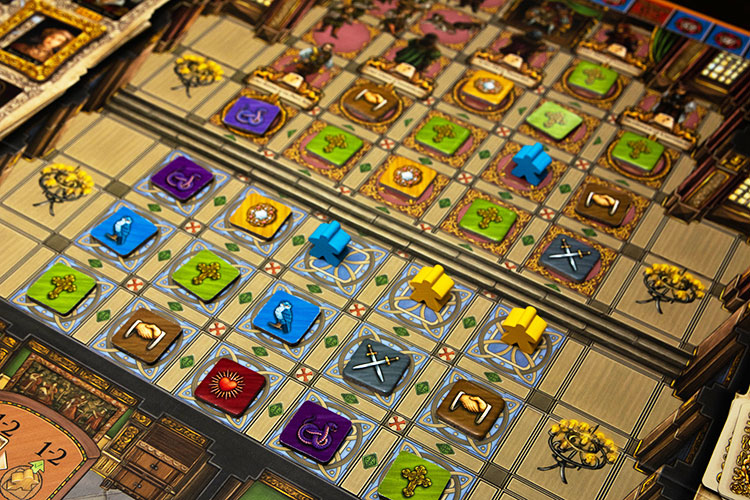 In Tudor, you will be a Lord during the time of King Henry the VIII trying to win prestige and influence. While my personal knowledge of King Henry VIII is mostly limited to what Herman’s Hermits have told me, the gist of it seems to be that he loves jewelry and wives. So, fittingly, the game rounds are timed to King Henry’s various wives and the more rings you have, the more powerful you will be.
In Tudor, you will be a Lord during the time of King Henry the VIII trying to win prestige and influence. While my personal knowledge of King Henry VIII is mostly limited to what Herman’s Hermits have told me, the gist of it seems to be that he loves jewelry and wives. So, fittingly, the game rounds are timed to King Henry’s various wives and the more rings you have, the more powerful you will be.
It’s kind of like a medieval version of Captain Planet. So let’s take a closer look at how it plays and if it’s right for your collection.
Gameplay Overview:
The setup of Tudor is what gives it quite a bit of its charm. Each game you’ll choose two scoring cards and a scenario card. The way these mix and match will have a profound impact on how you approach each game. You’ll also draft rings of the various houses to begin the game as each player will start with two rings on the giant hand in front of them.
From there, Tudor looks much like a worker placement game. There are three audience chambers, each with two different possible actions to take. You’ll place courtiers on the benches outside of those chambers, waiting to enter. Once everyone has placed their courtiers they will also be able to put their Lord, a special worker, in one of the chambers.

After all lords and courtiers have been placed, you’ll choose one of your figures to activate doing either of the actions that the room provides (or both actions if you activate your lord). In general, you’ll be using the actions to move courtiers around the throne room and collecting influence in the houses. The movement, generally, requires that you have a ring of the color you are moving onto or you have a card of that house.
Courtiers can only activate if a lord is present in the chamber, so it’s possible that some will just really sit around waiting for someone important to come in and tell them what to do. Never fear, the courtiers don’t clear the chamber each round. They will stay put from round to round unless additional courtiers are placed in the waiting rooms for those chambers. When those in the waiting room enter they will push out the courtiers who are already there.
Scoring during the game is basically a matter of collecting sets of these influence tiles, so you’ll be moving around the throne room as fast as possible, just chatting up people of important nobility getting more prestige. If you reach the top of any column on the throne room board you’ll earn a very fancy title which will grant you an additional ring. The rings not only dictate your movement in some cases, but also some of your actions become more powerful if you have rings placed in a certain way.
The game ends shortly after King Henry’s final marriage (the actual number of rounds are variable based on the scenario card). Points are scored based on the point cards from setup and the player with the most prestige is the winner.

Game Experience:
Seeing Tudor on the table is quite a sight. While it’s clearly a eurogame, the player screens are giant hands that you’ll be sliding plastic rings onto. This certainly gives the impression that there is something interesting going on here, and luckily, there is!
While it’s easy enough to call Tudor a worker placement game, it only is in the broadest sense. You’ll have a limited number of courtiers to place each round and a single Lord. But if you place courtiers in a room that doesn’t end up with a Lord, they won’t do anything at all. And your courtiers that do activate don’t leave, so with clever timing, they may be able to stick around and activate multiple times.

Once players all place their courtiers and Lords, however, the game loses a bit of luster. The actions all amount to moving around the throne room or collecting cards that you can use on a later action to move around the throne room. All in the name of gobbling up influence tiles that will score your points like they are pellets in Pac-Man. There isn’t anything bad about it, but the set collection doesn’t really do much to be different either.
The rings themselves, while not quite all for looks, don’t do as much for the gameplay as you might expect. If you happen to situate rings on certain fingers you might get to draw two cards and discard one. Or get a card back after you spend it to move if you move at least 3 spaces. These bonuses are nice, but not game-breaking. The rings are mostly used to help you gain influence with those particular houses but as a component, they are both functional and really fun.
I do appreciate the desire for variability with scoring cards and scenarios. There are three red scoring cards but they aren’t very different, they simply change the way you score your influence tiles at the end of the game. But the green ones can incentivize how you move around the throne room, giving you additional things to consider. For instance, one will score points for having the most courtiers in each column so you might want to move courtiers into positions to outnumber your opponents, even if it means you aren’t getting the exact influence tiles you’d normally want.

Final Thoughts:
Tudor is a neat eurogame that pushes for variability in the gameplay. The box includes 6 scoring cards (three of each color) so you’ll have nine different combinations you can use. That’s not even counting the scenario cards that change the number of rounds, the power of some of the special tiles, and the number of courtiers you’ll place each round.
Gameplay-wise Tudor leans heavily on the interesting timing and activation of placing courtiers and Lords. Hoping you’ll find the fun in trying to push your want into an audience chamber, displacing opponents, and having to guess which chamber everyone wants their Lord to go to. The moving around grabbing things part is fine—definitely similar to plenty of other games—but it’s a reasonable payoff for the other, more interesting parts.
Final Score: 3.5 Stars – A neat twist on worker placement with good variability. And rings for Captain Planet/Thanos jokes.
 Hits:
Hits:
• Workers persisting from round to round unless forced out is a fun mechanism.
• Lots of variability in scoring and scenario cards.
• Giant hands.
Misses:
• Set collection is a bit dull and uninspired.
• The ring powers are lackluster for as much as they dominate the look of the game.






















